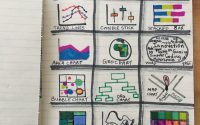9×1 = Outside In + Inside Out
 My first reflection for the 9x9x25 blogging challenge is a reflection of ‘what just happened in class this week’. It’s a Friday thing to do! Part of my usual routine is to reflect back over the classes I’ve taught this week, consider the highlights and those moments that may not have gone so well. When you teach online, there’s no particular class ‘space’ since it’s all taking place in online, asynchronous learning events. I teach in a physical classroom as well as online, so this reflection is about both.
My first reflection for the 9x9x25 blogging challenge is a reflection of ‘what just happened in class this week’. It’s a Friday thing to do! Part of my usual routine is to reflect back over the classes I’ve taught this week, consider the highlights and those moments that may not have gone so well. When you teach online, there’s no particular class ‘space’ since it’s all taking place in online, asynchronous learning events. I teach in a physical classroom as well as online, so this reflection is about both.
One highlight is that the outside world came into my classroom. Since I teach media and digital literacies at a Faculty of Education, this makes sense. The world outside the teaching spaces is filled with media. It’s filled with digital tools and resources. Just makes sense to bring them into the learning that students should be doing. This week, the outside world came into student learning in planned and unplanned ways. I had invited a friend, who actively works with teachers in classrooms, in her role as a curriculum consultant, to ‘drop in’ using a video conferencing tool, to talk to my students about what digital storytelling looks like in the classroom. She shared experiences, responded to questions, and created some thought provoking discussions after the chat ended. Thank you @AnnekeMcCabe for providing a window through which my students envisioned what it means to teach. You made it real. Thank you Peter Cameron, for continuing to inspire new teachers. Your previous conversations still bring the outside – In. That outside world of the classroom stepped through the screen and into the work of learning to teach, as viewed through your shared stories.
The outside world came into the classroom this week through Twitter. We’re dipping into this digital device to bring voices into the classroom, bring ideas in for scrutiny, bring social media to the forefront of teaching and learning. Twitter can be daunting for those new to this mechanism for communicating ‘from the inside out’, so we take it one little step at a time. I share the course twitter account @MDL4000 and my own account. Taking time to talk about terms of service, privacy, permissions, security, settings, choices, and voices is important. Making informed decisions is an important part of this process. It’s one way, but not the only way, to bring the outside world into the classroom. Through Twitter, I was able to bring a local news story into the classroom, since it directly connected to the work of the day – planning lessons with media curriculum expectations. Thanks Marie Swift, Maple Grove Public School, and CTV News Barrie for bringing the outside world of media production in education into the space where we’re tinkering with all those elements and learning how to make media matter.
The inside is also moving out. As students venture into digital spaces, they are leaving the safe confines of the controlled and bounded learning spaces, stepping out – virtually speaking – into the wider world through the social media and digital tools they are using. I’m asking students to build a blog site, to use for the course, or as an ongoing location where a digital presence as a professional can be created and crafted with care. These are incorporated into the course tasks and shaped over time. They are just getting started and I’m now taking a peek at them, in order to provide feedback. It’s an outside, non-learning management, openly web accessible way for students to put their thinking into the wider world, where it can spark more thinking about the topics of the course. It’s a process of ‘putting it out there’, thinking out loud, making learning visible. It’s not meant to be perfect, but it is intended as a way to grow in digital fluency, proficiency, while thinking deeply about issues and opportunities. It’s intended to help build connections, both inside the brain’s neural networks, and outside the brain, with external networks of people and ideas bumping up against each other.
The movement out of confined spaces is not always easy or comfortable. This week was the first time I have asked students to leave a video recorded discussion response using a closed, password protected Flipgrid space, instead of their usual text based discussion post in the learning management system. It wasn’t easy. My own experience of recording myself talking ‘to the screen’ as if I’m talking ‘through the screen’ has pushed my personal teaching practice well past my comfort zone. This notion of envisioning the other person or people on the ‘other side’ was shared by Jesse Stommel and Sean Michael Morris on the Teaching in Higher Ed Podcast, Episode 224:An Urgency of Teachers with Bonni Stachowiak. Thanks to several years of sharing conversations through a screen with Virtually Connecting, this isn’t as difficult as it once was – there’s still some trepidation, but not fear. It’s more comfortable bringing my-self to these outside spaces.
So that’s my 25 sentences (or more) about what I’m teaching, what I’m learning as I’m teaching, and what my media making magic may make happen, when the outside comes in, and the insides move out.
Image Attribution: Photo by Aditya Saxena on Unsplash


